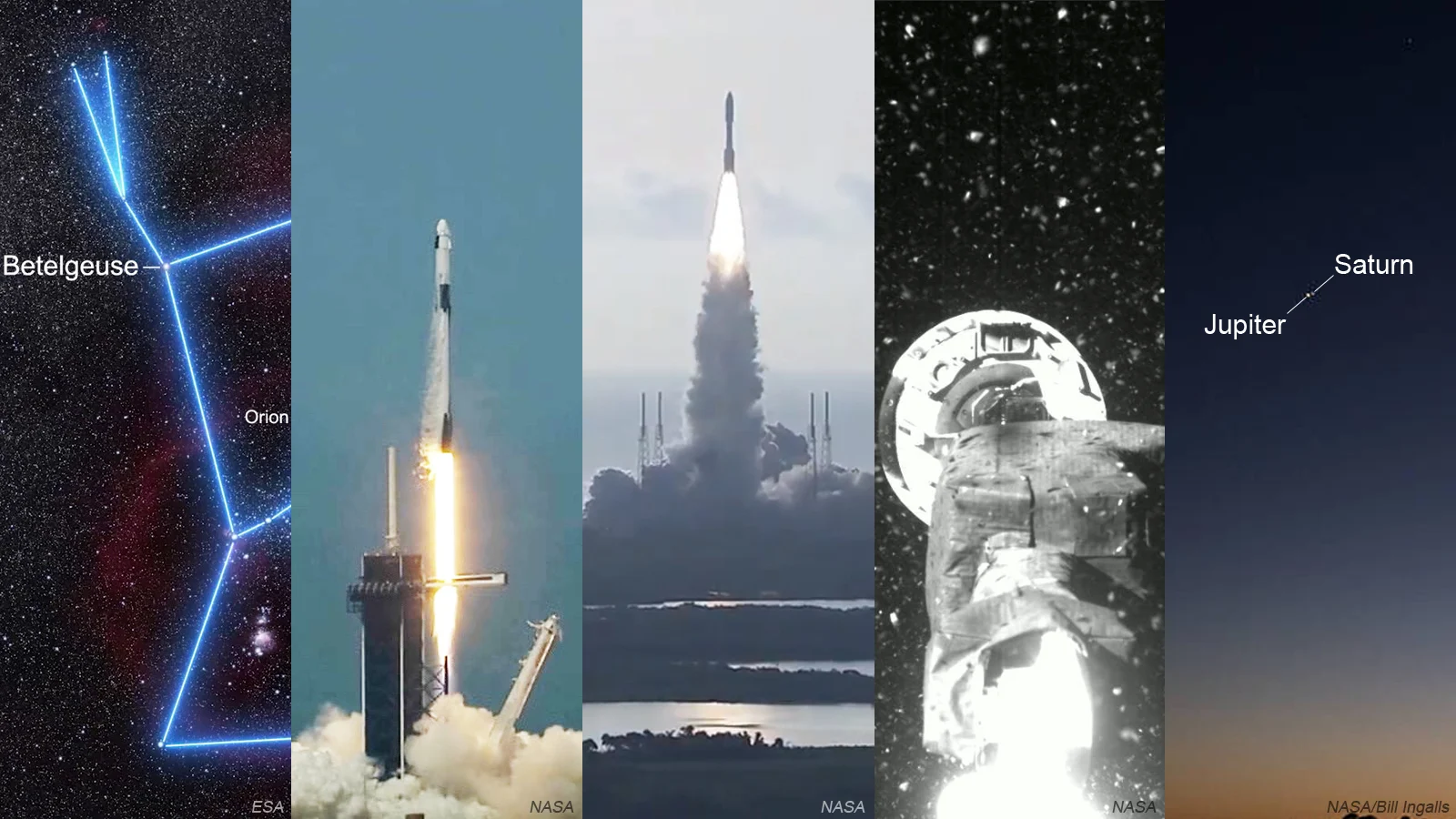
Mysteries and milestones: Our top five space stories of 2020
It was a busy year, but here are the best of the best from space.
From cosmic mysteries to groundbreaking space missions to extraordinary sights in our sky, 2020 will be a memorable year. It wasn't easy narrowing down the list, but here are the top five space stories of the year.
BETELGEUSE'S MYSTERY DIMMING
The star Betelgeuse, which occupies the right shoulder of the constellation Orion, is a red supergiant, presented astronomers — both amateur and professional — with a profound mystery to start off the year. Although around a thousand times larger than the Sun and substantially brighter, Betelgeuse was noticeably dimming.
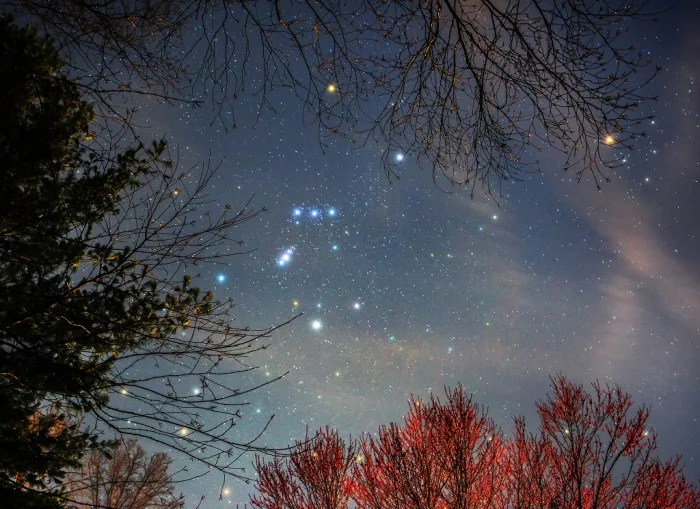
Betelgeuse occupies the right shoulder of the constellation Orion. Credit: NASA
While Betelgeuse is known to go through dimming and brightening phases, roughly every 420 days, the dimming that started towards the end of 2019 was very unusual. Usually, the average stargazer wouldn't notice Betelgeuse's brightening and dimming. By February 2020, though, everyone saw it! The star had lost about two-thirds of its brightness!
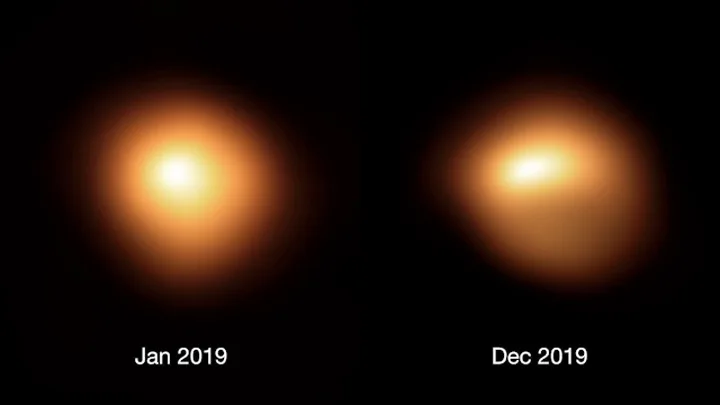
Two views from the ESO's Very Large Telescope, nearly a year apart, capture the dimming of Betelgeuse, which was affecting the lower half of the giant star. Credit: ESO/M. Montargès et al.
It took astronomers months to figure out what was likely going on. Apparently, the volatile star blasted out a 'stellar sneeze' — an immense gas cloud that cooled as it expanded into space and blocked out much of the light from the star's southern half.
Why is this important? This bizarre event was something that the public could share with scientists, as we could all look up at Orion and see how dim Betelgeuse was. It also caused quite a bit of speculation about whether this ageing star was going supernova! In addition, it helped scientists to learn more about stars, and it may have also revealed that Betelgeuse might not be as old as we think it is (putting off its chances to go supernova for a looong time).
FIRST CREWED LAUNCH FROM AMERICA
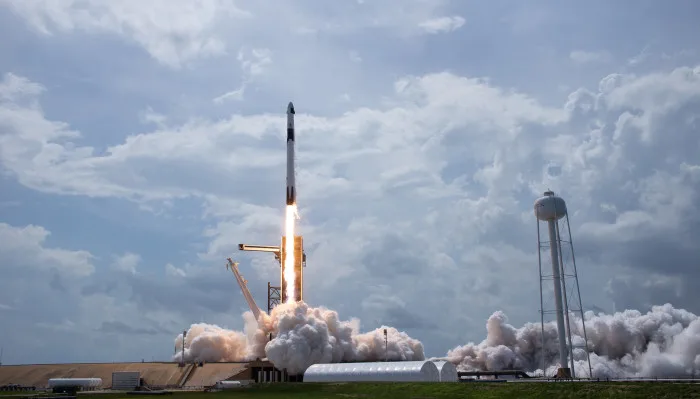
SpaceX's Demo-2 mission launched a Crew Dragon with the first astronauts to lift off from US soil since 2011. Credit: NASA TV
On May 30, 2020, NASA and SpaceX broke a nearly decade-old dry-spell for crewed space launches from American soil. That afternoon, a Falcon 9 booster rocket blasted off from Kennedy Space Center's Launch Complex 39A, carrying the Demo-2 mission into orbit. On board the Crew Dragon spacecraft perched atop that rocket were astronauts Bob Behnken and Doug Hurley, on their way to the International Space Station.
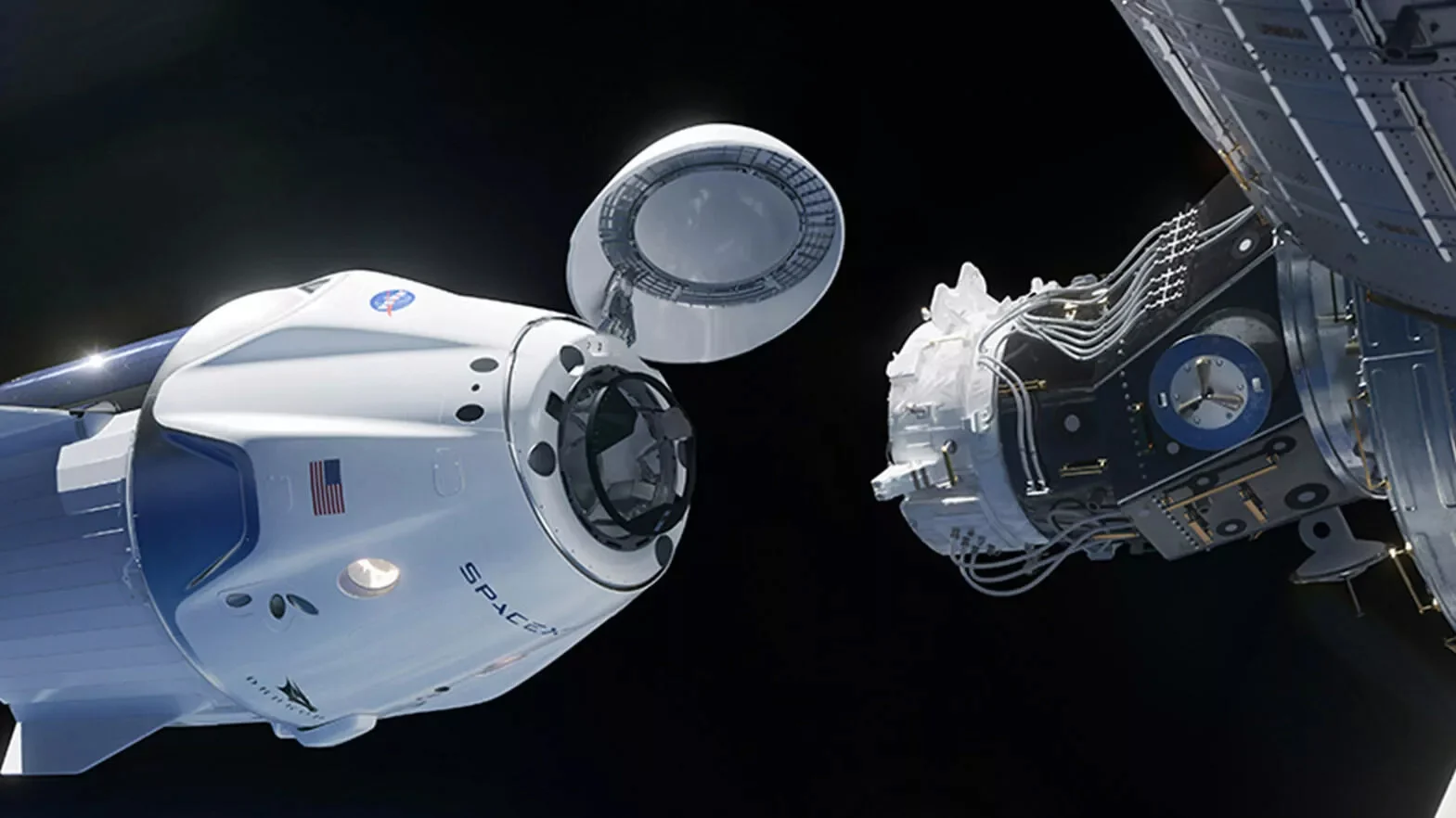
Crew Dragon carrying Demo-2 astronauts Bob Behnken and Doug Hurley arrives at the ISS on May 31, 2020. Credit: NASA TV
With the success of this flight, SpaceX went on to launch the first official commercial flight to the ISS from America on November 15. NASA astronauts Michael Hopkins, Victor Glover, and Shannon Walker, and JAXA astronaut Soichi Noguchi, lifted off on this historic flight, joining Expedition 64 on board the space station.
Why is this important? The July 8, 2011 lift-off of the Space Shuttle Atlantis was the final launch of the US space shuttle program. For nearly a decade after, astronauts from around the world had only one avenue to space — the Russian Soyuz program. This put a limit on who could go to space and when. A return to launching crewed spacecraft from American soil opens up another way to get to the Space Station, which will undoubtedly increase the opportunities for everyone.
PERSEVERANCE LEAVES FOR MARS
NASA's new Perseverance Rover lifted off from Kennedy Space Center on July 30, 2020, beginning a roughly six-month journey to its destination on Mars.
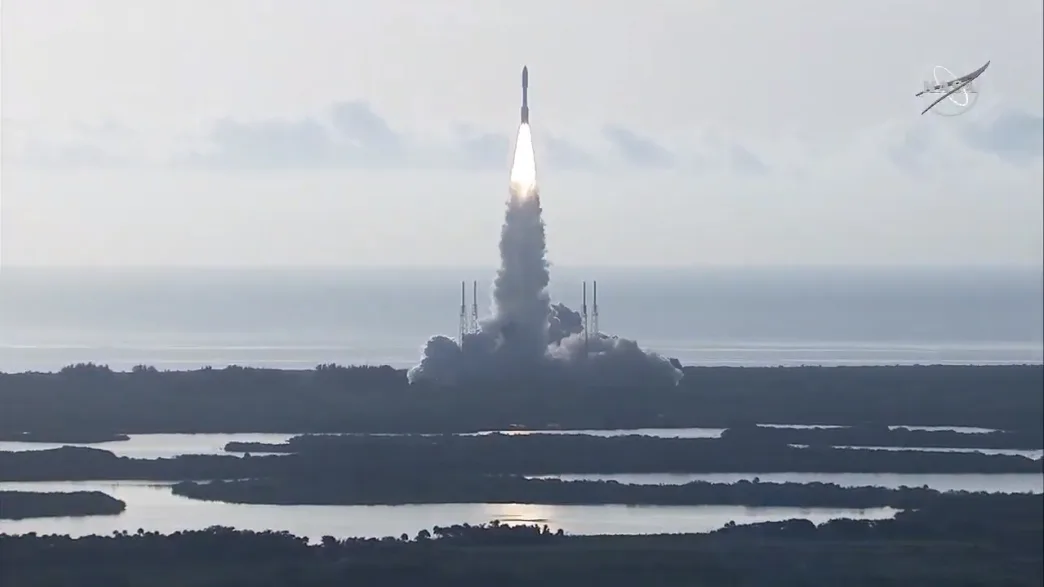
Perseverance launches atop an Atlas V rocket on July 30. Credit: NASA TV
Perseverance is scheduled for a February 18, 2021 landing in Jezero, a 45-km-wide impact crater in Mars' northern hemisphere. Very similar to the Curiosity rover, Perseverance is a nuclear-powered robot that will explore Jezero on behalf of its science team back here on Earth.
Unlike Curiosity, though, Perseverance isn't alone. It is carrying a tiny drone companion named Ingenuity, which will be the very first attempt at powered flight on Mars.
Perseverance and Ingenuity's mission is to search Jezero, which was once a lake with an extensive river delta, for signs that some form of life was there, long ago.
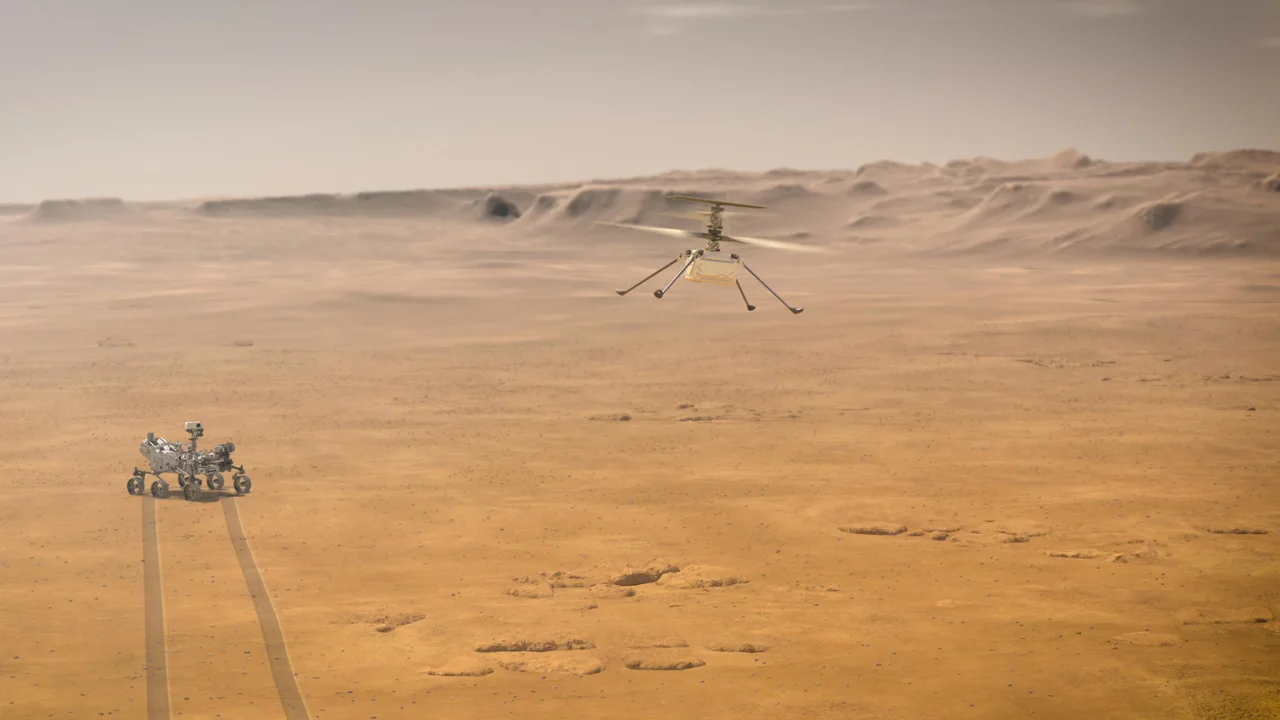
This artist's rendering shows what Perseverance and Ingenuity will look like on the surface of Mars. Credit: NASA/JPL-Caltech
Why is this important? Even as far back as the Viking lander mission in the late 1970s, there have been compelling signs that life may exist, or may have existed at one point, on Mars. Previous missions determined that Mars had the right conditions to support life. If Perseverance can discover definite signs that the planet actually did support life, it may be one of the most important discoveries ever made. Also, if life once existed on Mars, it may still be there, right now.
OSIRIS-REX GATHERS A SAMPLE OF BENNU
After months of exploring near-Earth asteroid Bennu, mapping its surface and making extraordinary discoveries, NASA's OSIRIS-REx spacecraft tapped down on the space rock's surface, blasting away a sample that it will return to Earth.
Days after the spacecraft tagged Bennu, it was confirmed that it had actually retrieved too large of a sample. So much was collected that the collection capsule door couldn't close, and bits of Bennu were escaping back into space! Fortunately, the team was able to properly stow the sample, and early next year, OSIRIS-REx will begin the journey back to Earth to deliver its prize.
Why is this important? Given what we know of our planet's history, one stray asteroid can become a BIG problem for anyone living here. There are no known asteroid threats currently. Still, knowing everything we can about these objects will mean that if one does become a danger to us, we can develop effective ways of dealing with it. OSIRIS-REx's study of Bennu adds to our knowledge, but the return of its pristine sample will provide even more insight into the makeup of these asteroids.
THE GREAT CONJUNCTION
We started off the year with a rather amazing sight in the sky, so it was only fitting that we end the year in the same way. All year long, the planets Jupiter and Saturn were hanging out together each night. Throughout Fall, however, they slowly crept closer and closer to each other, and on the night of the Winter Solstice, they appeared to merge.
This was the Great Conjunction of 2020.

Just after sunset on December 21, 2020, skywatchers with their eyes turned to the southwest could see a bright 'solstice star' near the horizon. At the time, Jupiter and Saturn were just one-tenth of a degree apart in the sky. This was the closest conjunction of Jupiter and Saturn since 1623 and the closest easily visible conjunction in nearly 800 years!

The Great Conjunction photographed from Chapel Hill, North Carolina, on Monday, December 21, 2020. Credit: NASA/Bill Ingalls
Why is this important? In a way, this conjuction of Jupiter and Saturn had a great value for science. However, the real importance of this event was that it was just super cool!
Okay, despite the XKCD comic, Jupiter and Saturn were never going to kiss. This event was still great, though, because it was something everyone could enjoy. Plus, as an added bonus, this wasn't something that was happening only on one night, at one exact moment in time. While the conjunction itself took place at one moment, stargazers had been watching the slow approach of these two planets for months. Even now, days after the official conjunction, the show continues as we can still watch them as they slowly draw apart!











